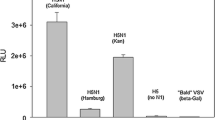Summary
The sequential expression of a vaccinia virus specific antigen on the surface of infected cells has been followed by125I-labelled anti-vaccinia IgG. After an initial drop (during the first 30 minutes of infection) the amount of viral antigen at the cell surface increased steadily for the 12 hours tested. The expression of the antigen was found to depend on protein and RNA synthesis from the start, but dependent on DNA synthesis only after 4 hours. The sensitivity of the phenomenon to ultraviolet light irradiation of the virus suggests that the genetic information needed for the expression of the antigen resides in the viral genome. The antigen has been identified as the virion surface tubule, a tubule-like structure on the surface of the intact virion. It is known that vaccinia virus infection of cells starts with the fusion of the virion envelope with the host plasma membrane.
It is here proposed that initially tubule from input virus is detected as viral antigen on the cell surface. Subsequently, virus tubule protein synthesisedde novo migrates and is detectable as the virus specific cell surface antigen.
Similar content being viewed by others
References
Armstrong, J. A., Metz, D. H., Young, M. R.: The mode of entry of vaccinia virus into L cells. J. gen. Virol.21, 533–537 (1973).
Bakay, M., Burke, D. C.: The production of interferon in chick cells infected with DNA viruses; a search for double stranded RNA. J. gen. Virol.16, 399–403 (1972).
Brier, A. M., Wohlenberg, C., Rosenthal, J., Mage, M., Notkins, A. L.: Inhibition or enhancement of immunological injury of virus infected cells. Proc. Natl. Acad. Sci. U.S.A.68, 3073–3077 (1971).
Brown, M., Dorson, J. W., Bollum, F. J.: Terminal ribo-adenylate transferase: a poly A polymerase in purified vaccinia virus. J. Virol.12, 203–208 (1973).
Chang, Anabella, Metz, D. H.: Further investigations on the mode of entry of vaccinia virus into cells. J. Virol.32, 275–282 (1976).
Cohen, G. H., Wilcox, W. C.: Soluble antigens of vaccinia infected mammalian cells III. Relation of “early” and “late” proteins to virus structure. J. Virol.2, 449–455 (1968).
Dales, S.: The uptake and development of vaccinia virus in strain L cells followed with labelled viral deoxyribonucleic acid. J. Cell Biol.18, 51–72 (1963).
Dulbecco, R.: Production of plaques in monolayer tissue culture by single particles of an animal virus. Proc. Natl. Acad. Sci. U.S.A.38, 747–752 (1952).
Fujio, Y.: Detection of haemagglutinin production of vaccinia virus by haemadsorption. Biken J.5, 109–111 (1962).
Gardner, I., Bowern, N. A., Blanden, R. V.: Cell-mediated cytotoxicity against ectromelia virus infected target cells. I. Specificity and kinetics. Europ. J. Immunol.4, 63–67 (1974).
Hanafusa, T.: Enzymatic synthesis and breakdown of deoxyribonucleic acid by extracts of L cells infected with vaccinia virus. Biken J.4, 97–110 (1961).
Hayashi, K., Rosenthal, J., Notkins, A. L.:125I-labelled antibody to viral antigens: Binding to the surface of virus-infected cells. Science176, 516–518 (1972).
Kajioka, R., Siminovitch, L., Dales, S.: The cycle of multiplication of vaccinia virus in Earle's strain L cells. II. Initiation of DNA synthesis and morphogenesis. Virology24, 295–309 (1964).
McConahey, P. J., Dixon, F. J.: A method of trace iodination of proteins for immunologic studies. Int. Arch. Allergy Appl. Immunol.29, 185–189 (1966).
Medzon, E. L., Bauer, H.: Structural features of vaccinia virus revealed by negative staining, sectioning and freeze-etching. Virology40, 860–867 (1970).
Miyamoto, H., Kato, S.: Cell surface antigens induced by poxviruses. I. Effects of antimetabolites on cell surface antigens. Biken J.14, 311–324 (1971).
Morgan, J. F., Morton, H. J., Parker, R. C.: Nutrition of animal cells in tissue culture. Initial studies on a synthetic medium. Proc. Soc. exp. Biol. Med.73, 1–10 (1950).
Morgan, C., Rifkind, R. A., Rose, H. M.: The use of ferritin-conjugated antibodies in electron microscopic studies of influenza and vaccinia viruses. Cold Spring Harbour Symp. quant. Biol.27, 57–66 (1962).
Munyon, W., Mann, J., Grace, J. T. Jr.: Protection of vaccinia from heat inactivation by nucleotide triphosphates. J. Virol.5, 32–38 (1970).
Noyes, W. F.: The fine structure of vaccinia virus. Virology17, 282–287 (1962).
Rosenthal, J., Hayashi, K., Notkins, A. L.: Virus antigens on the surface of infected cells: Binding and elution of125I-labelled antivirus antibody. J. gen. Virol.18, 195–199 (1973).
Sheldon, R., Kates, J.: Mechanism of poly A synthesis by vaccinia virus. J. Virol.14, 214–224 (1974).
Sime, E. H., Bedson, H. S.: A comparison of ultraviolet action spectra for vaccinia virus and T2 bacteriophage. J. gen. Virol.18, 55–60 (1973).
Ueda, Y., Ito, M., Tagaya, I.: A specific surface antigen induced by poxvirus. Virology38, 180–182 (1969).
Ueda, Y., Tagaya, I., Amano, H., Ito, M.: Studies on the early antigens induced by vaccinia virus. Virology49, 794–800 (1972).
Author information
Authors and Affiliations
Additional information
With 3 Figures
Rights and permissions
About this article
Cite this article
Harry, T.O. Expression of vaccinia virion surface tubule protein as a virus specific cell surface antigen. Archives of Virology 58, 235–241 (1978). https://doi.org/10.1007/BF01317605
Received:
Accepted:
Issue Date:
DOI: https://doi.org/10.1007/BF01317605




